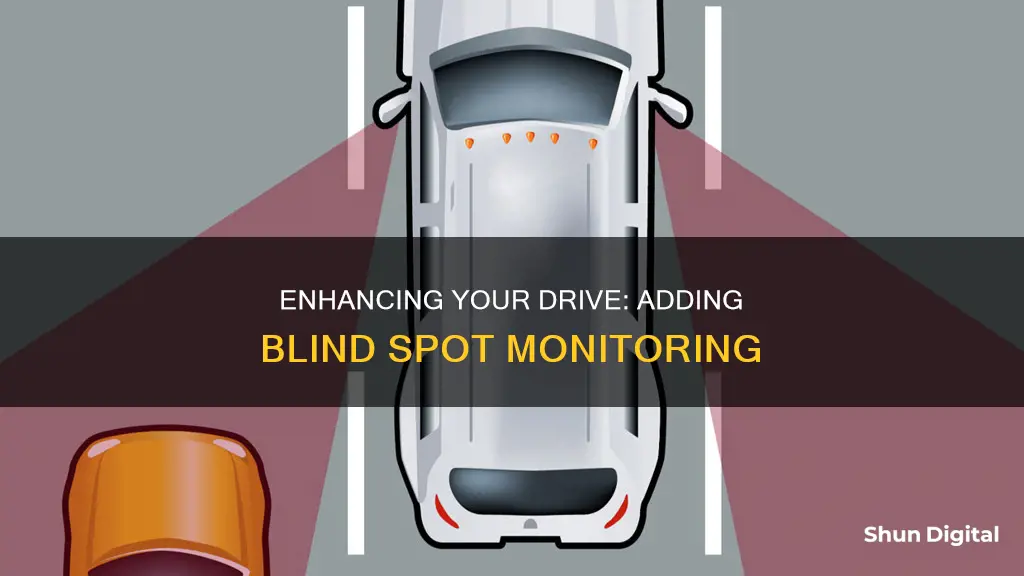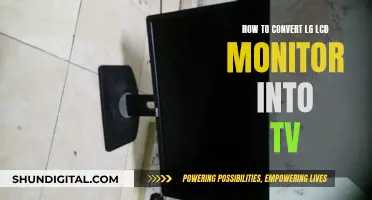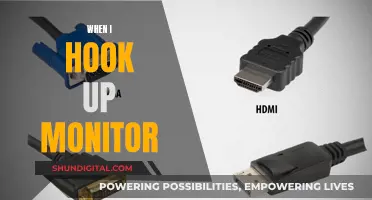
Blind spots can be dangerous, and many modern cars come with built-in blind spot monitoring systems. However, if your car doesn't have one, you can install an aftermarket blind spot monitor. These systems use sensors on the side mirrors or rear bumper to detect vehicles in adjacent lanes, alerting you through visual or audio cues. While some suggest that simply adjusting your mirrors properly is enough, others feel that aftermarket blind spot monitoring systems are a good idea, especially for larger vehicles or those with limited visibility. These systems can be universally applied to most vehicles, and while professional installation is recommended, it is possible to install them yourself.
What You'll Learn
- Blind spot monitoring systems can be purchased and installed by the driver themselves
- Aftermarket blind spot monitoring systems are available for older vehicles
- Blind spot monitoring systems can be purchased from eBay and other online retailers
- Blind spot monitoring systems can be purchased from third-party sellers
- Blind spot monitoring systems can be purchased and installed by dealerships

Blind spot monitoring systems can be purchased and installed by the driver themselves
Aftermarket blind spot monitoring kits are available from various retailers and can be purchased online or in-store. The cost of these systems varies, ranging from $250 to $500 or more. The more affordable systems may have limited functionality and accuracy, while the higher-end systems offer greater reliability and accuracy. It is important to do some research and choose a system that is compatible with your vehicle's age, make, and model.
Once you have purchased the system, you can follow these general steps to install it:
- Place the measuring tape parallel to your vehicle's wheels and align the calibration cloth from your system behind the vehicle at a 90-degree angle.
- Use a level to draw a straight line on the vehicle's rear bumper.
- Remove the rear bumper and, if necessary, the taillights.
- Clean the calibrating positions in the inner rear bumper with a cleaning cloth and rubbing alcohol.
- Place the magnets included in the system on the outside of the vehicle, following the marked lines, and adjust the placement of the sensors as needed.
- Mark the spot inside the bumper where the magnet rests and apply adhesive to the sensors before sticking them in place.
- Mount the LED indicators inside your vehicle's cabin in a location that is easily visible without taking your eyes off the road.
- Adjust the volume of the indicators to ensure it is at a suitable level.
It is important to note that these steps are general guidelines, and you should always refer to your specific vehicle's instructions for installation. If you encounter any issues or have any questions during the installation process, it is recommended to reach out to a service center or a professional for assistance.
Installing a Reversing Camera: LCD Mirror Monitor Guide
You may want to see also

Aftermarket blind spot monitoring systems are available for older vehicles
Aftermarket blind spot monitoring systems can increase driving awareness, assist drivers of larger vehicles, prevent crashes, and increase response time. They can be especially useful for drivers who have difficulty turning their necks or checking their blind spots. These systems use sensors, cameras, or mirrors to detect vehicles in adjacent lanes and alert the driver through visual or audio warnings.
When choosing an aftermarket blind spot monitoring system, it is important to consider the accuracy of the sensors, the ease of installation, and the cost. The most affordable systems cost $250 and under, while higher-end systems can cost $500 or more. Professional installation is recommended, but it is also possible to install these systems yourself with the help of instructions provided by the manufacturer.
Some examples of aftermarket blind spot monitoring systems available on Amazon include:
- Ultrasonic Blind Spot Detection System
- Car blind spot camera and display system
- Blind Spot Monitoring System with 77 GHz Millimeter Wave Radar
- LivTee Blind Spot Mirror
Finding Nits: Monitor Inspection Techniques for Beginners
You may want to see also

Blind spot monitoring systems can be purchased from eBay and other online retailers
In addition to Amazon, there are other online retailers that sell blind spot monitoring systems. For instance, Rear View Safety offers a variety of systems, including the RVS-131 RADAR BLIND SPOT DETECTION SYSTEM- 77GHZ and the RVS-118 Blind Spot Sensor System. Similarly, Haloview offers the SENS 3 BSD System, which can be installed without drilling and provides both visual and audible alerts.
Online forums, such as Reddit, can also be a source of recommendations for blind spot monitoring systems. For instance, in a discussion about adding aftermarket blind spot detection to a Subaru Impreza, users suggested the Accele BSS200 Blind Spot Sensor Kit and convex mirrors as potential options.
It is important to note that while aftermarket blind spot monitoring systems can be purchased online, professional installation is often recommended to ensure proper functionality and safety.
HP V212 Monitor: Know the Exact Dimensions
You may want to see also

Blind spot monitoring systems can be purchased from third-party sellers
Aftermarket blind spot monitoring kits are offered by start-up companies and major auto parts companies, and the market for these kits is growing. Many of these kits are universal, meaning they can be used regardless of the age, make, and model of the vehicle. However, it is important to choose a system that is compatible with your vehicle.
When purchasing a third-party blind spot monitoring system, you will also need to decide which type of alerts you prefer. Some systems use visual alerts, such as illuminated lights in the side mirrors, while others use audible alerts, such as chimes or beeps.
The price of aftermarket blind spot monitoring systems varies. The most affordable systems are $250 or less, while mid-range options cost between $250 and $500. The higher-end systems cost $500 or more and offer greater accuracy and reliability.
When installing a third-party blind spot monitoring system, it is recommended to follow the manual or seek professional installation. While some systems may require complex installation processes, others can be easily installed by the user.
Understanding Monitor Hertz: A Guide to Finding Your Display's Hz
You may want to see also

Blind spot monitoring systems can be purchased and installed by dealerships
When choosing a blind spot monitoring system, it's important to consider the accuracy of the blind spot sensors and the ease of installation. While some systems are designed for specific vehicle models, others are universal and can be used regardless of the age, make, and model of your car. It's also worth noting that the cost of blind spot monitoring systems can vary depending on their features and accuracy. The most affordable systems typically cost around $250 or less, while high-end systems can cost $500 or more.
In addition to dealerships, there are also specialised audio and auto shops that can install blind spot monitoring systems. These shops often have experienced technicians who can provide custom solutions and ensure a proper installation. They may also offer a range of other car accessories and services, allowing you to enhance your vehicle further.
Whether you choose to go to a dealership or a specialised shop, it's always a good idea to get multiple quotes and do some research to find the best option for your needs and budget.
Monitoring Contractions: What to Look For and How to Prepare
You may want to see also
Frequently asked questions
An aftermarket blind spot monitor is an ideal addition if your vehicle is not equipped with a blind spot detection system. This system notifies the driver if another vehicle has appeared within their blind zone and is at risk of a collision.
There are two main components to aftermarket blind spot monitoring systems. First, the sensor acts as a visual aid to perceive the environment. Second, the indicator will inform the driver that there is a potential danger. By using radar, and/or ultrasonic sensors, drivers will receive a visual and/or audible alert that there is potential danger in a car blind spot.
Aftermarket blind spot monitoring systems vary in price. The most affordable system sells for $250 and under. The mid-range cost is between $250-500, and the higher-end systems cost $500 or more.







